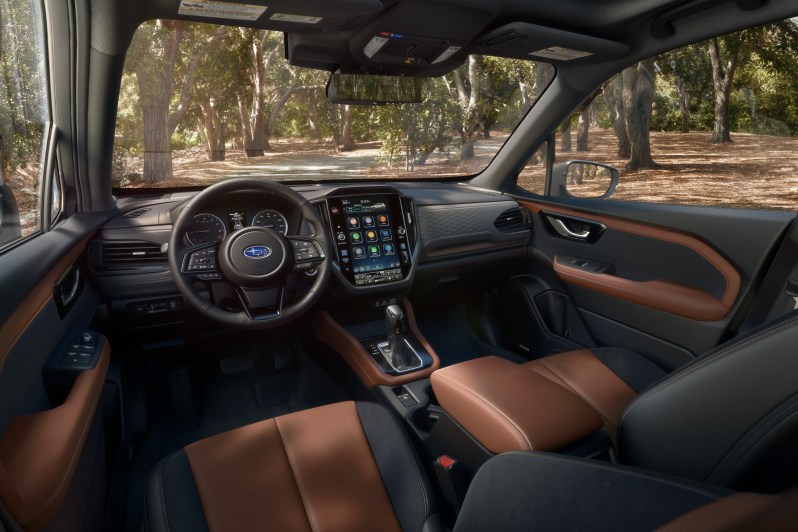
Subaru introduced the sixth-generation 2025 Forester SUV in five trim levels. The sixth variant, the Forester Wilderness, remains unchanged for 2025 because Subaru redesigned the 2024 version of the more rugged, off-road trim. Like all Subaru SUVs and most sedans, the 2025 Forester trims have full-time, symmetrical all-wheel drive (AWD), four-cylinder Boxer internal combustion engines (ICEs), and continuously variable transmissions (CVTs).
Why 2025 Subaru Forester trim levels matter

Unless you already own a Subaru, and even then, discerning the changes between years is difficult. Walk on a Subaru dealership lot with new cars mixed with used models, and it’s easy to mistake a 10-year-old Forester or Outback for a spanking new version. Subaru doesn’t make drastic design changes. The brand’s value point is based on reliability and durability, much more than attracting attention with spiffy new profiles.
In addition to barely noticeable design tweaks, Subaru makes a few changes yearly, typically updating, upgrading, or improving existing features or adding new ones. The impression is that rather than reinventing models every few years, Subaru focuses on improving each model incrementally.
The Subaru formula surely works. Subarus is most popular across the northern United States because of its well-deserved reputation for driving and handling in snow and cold temperatures. Also, Subarus typically have significantly higher resale value than most other brands.
All prices listed below for the various Forester trims include destination and delivery fees.
Here’s what’s new with the 2025 Subaru Forester

All 2025 Subaru Forester trims have a 10% stiffer chassis, and Subaru’s Advanced EyeSight Driver Assist Technology is now standard equipment. The EyeSight system has a wider field of view, updated software, and a new electric brake booster. Subaru claims the Forester’s Symmetrical AWD has faster response, more agile handling, and better control on all road surfaces.
The base Forester model’s standard equipment includes 17-inch alloy wheels, adaptive cruise control with lane centering, steering-responsive LED headlights, dual-zone automatic climate control, and roof rails. It starts at $31,090.
2025 Subaru Forester Premium

Starting at $33,390, again with destination fees, the 2025 Subaru Forester Premium is the first step up in trim levels from the base model. The Forester Premium gains the StarLink 11.6-inch MultiMediaPlus System touchscreen with support for wireless Android Auto and Apple CarPlay. The Premium trim includes wireless charging, dual USB-A and USB-C charge ports, a Wi-Fi hotspot, AM/FB radio, and HD radio.
Other features standard with the Premium grade include a 10-way power driver’s seat, moonroof, leather-wrapped steering wheel, all-weather package with heated front seats, and Subaru’s X-Mode with Hill Descent Control. Optional Blind-Spot Detection with Rear Cross-Traffic Alert plus a power rear liftgate is available for $1,200 with the Premium trim.
2025 Subaru Forester Sport

The 2025 Forester Sport trim has unique styling touches, including bronze-finished 19-inch alloy wheels, Sport badging, StarTex upholstery, and upgraded X-Mode. The Sport grade also adds Blind-Spot detection with Lange Change Assist and Rear Cross-Traffic Alert, Automatic Emergency Steering, and more agile suspension tuning. The Forester Sport starts at $35,890.
For an extra $1,700, the Sport trim options bundle includes a power rear gate, Reverse Automatic Emergency Braking, engine performance management with two modes, and an 11-speaker Harman Kardon premium audio system.
2025 Subaru Forester Limited

Stepping up to the 2025 Forester Limited, starting at $37,390, owners can enjoy leather seating, a foot-activated power rear gate, a heated steering wheel, and the Premium grade features. For $1,600, the Limited options package comes with the 11-speaker Harman Kardon audio system, navigation, and Reverse Automatic Braking.
2025 Subaru Forester Touring

Starting at $41,390, the 2025 Forester Touring is the highest trim level, adding to the Limited feature list 19-inch alloy wheels, 360-degree Surround View Monitor, two-position driver memory seats, heating rear outboard seats, a low-profile roof rack, smart rearview mirror, and perforated leather-trimmed seating with suede bolsters. The Touring model also has an 11.6-inch multimedia display with navigation, 11-speaker audio, Subaru’s DriverFocus Distraction Mitigation System, and Reverse Automatic Braking.
2025 Subaru Forester Wilderness

The 2025 Subaru Forester Wilderness, with greater ground clearance, a water-resistant seating surface, all-weather mats, and a cargo tray, starts at $36,315, including destination and delivery fees. A $1,850 option package for the Wilderness model includes an 8.0-inch display with a navigation system, a 9-speaker Harman Kardon audio system, and a power rear liftgate.



